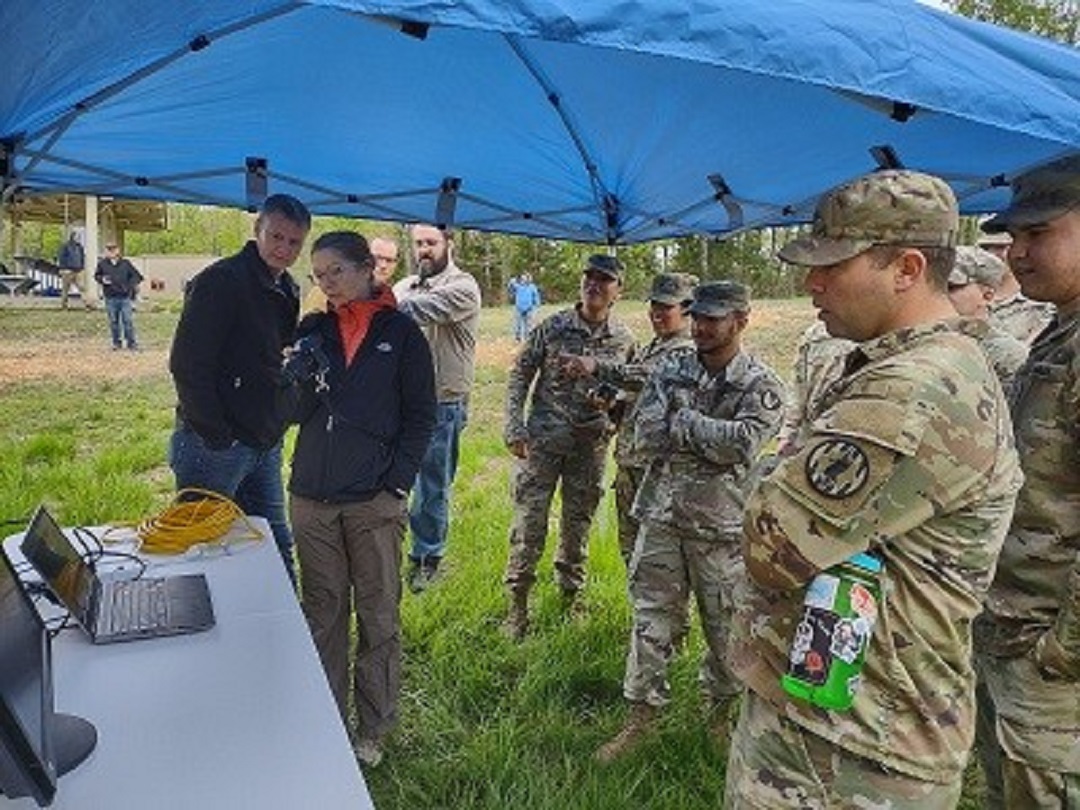// NEWS RELEASE
CBC Technologies Gain Early Soldier Touchpoints at 2022 MSSPIX
CCDC Chemical Biological Center Public Affairs | July 8th, 2022
CBC Technologies Gain Early Soldier Touchpoints at 2022 MSSPIX
DEVCOM CBC Public AffairsJuly 8th, 2022

Soldiers and the Chemical Biological Center’s Person Born Improvised Explosive Devices team observe the DRAGONFLY2 experiment at the 2022 Maneuver Support, Sustainment, and Protection Integration Experiments.
Aberdeen Proving Ground, MD — Scientists from the U.S. Army’s Combat Capabilities Development Command Chemical Biological Center (DEVCOM CBC) were invited to the 2022 Maneuver Support, Sustainment, and Protection Integration Experiments (MSSPIX) at Fort Leonard Wood, Missouri, to let Soldiers get their hands on chemical biological defense technology they have under development.
Last month, the Center’s Person Born Improvised Explosive Devices (PBIED) program traveled to MSSPIX in Fort Leonard-Wood, Missouri to demonstrate “DRAGONFLY2” and its “pWave”. They are two prototypes being developed under the Small Business Innovation Research program.
DRAGONFLY2 is a broad band long-wave infrared physical security camera that is software enabled to perform autonomous detection and alarm against PBIEDs and biological aerosol plumes. pWave is a unique millimeter wave imager that provides real-time full scene video imaging of hidden threats. This next-generation technology is being developed to address threats ranging from hidden personnel, explosively formed penetrators and wires.
According to Center research scientist and Army PBIED Thrust Area Lead, Dr. James Jensen, both technologies use additional concurrent capture of visible images along with the primary images and image processing techniques to enhance situational awareness and reduce cognitive burden.
MSSPIX was created to showcase the work of startup technology development companies. “This is a huge cost-effective opportunity. You bring your technologies in, let the battle laboratory know what your learning demands are, and depending on resources and priorities that year, they choose which experiments they want to run,” Jensen said.
He added that, “The PBIED team was able to perform these experiments in a low risk venue, bring the Soldier back into the development cycle, and achieve all of this at low cost.”
CBC’s Liaison Officer (LNO) for the event, David Glynn, found it exciting. Having Glynn as a support to their team was invaluable according to Jensen. “As an LNO, Glynn was able to serve as a conduit between the Center’s scientists and engineers, and Soldiers. He helped bridge communication between the two entities during the MSSPIX event.”
“As a retired Army Soldier, Glynn has experience with the operational environment that warfighters find themselves in. He was able to help the battle laboratory and scientists simulate that environment in an experimental setting and act as an interpreter between the two different types of subject matter experts,” said Jensen.
Glynn said, “We were able to successfully achieve early user feedback in the development of an emerging capability. This is a critical component of the development of emerging technologies because it allows the system to fail early, fail cheap and fail safely.”
The Center’s team of scientists and engineers also participated in the MSSPIX VIP day where military leaders observe the experiments. In attendance was the Commanding General for Maneuver Support Center of Excellence, Major General, James Bonner and the Deputy Director of the U.S. Army’s Army Futures Command-Futures Command Center, Brigadier General Guy M. Jones.
The PBIED team is currently applying the feedback that they received from the Soldiers at MSSPIX and are back at work in the laboratory. “The MSSPIX venue, and warrior experiment venues like it offer us an unprecedented opportunity to understand the problem from the soldier’s point of view,” said Jensen.
The U.S. Army Combat Capabilities Development Command (DEVCOM) leads in the discovery, development and delivery of technology-based capabilities to enable Soldiers to win our nation’s wars and come home safely. DEVCOM is a major subordinate command of the U.S. Army Futures Command. The DEVCOM Chemical Biological Center is the Army’s principal research and development center for chemical and biological defense technology, engineering and field operations. The DEVCOM Chemical Biological Center is headquartered at Aberdeen Proving Ground, Maryland.
